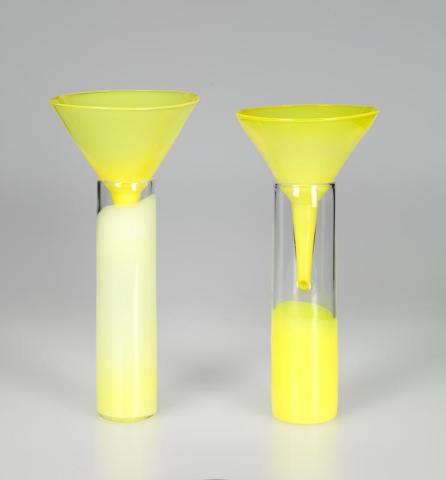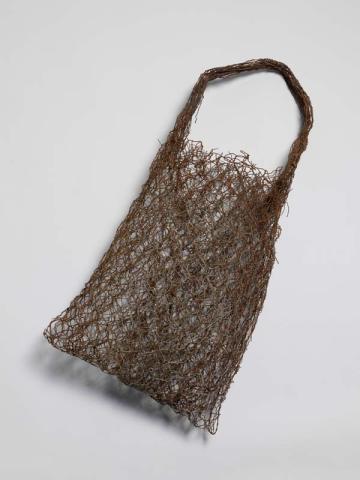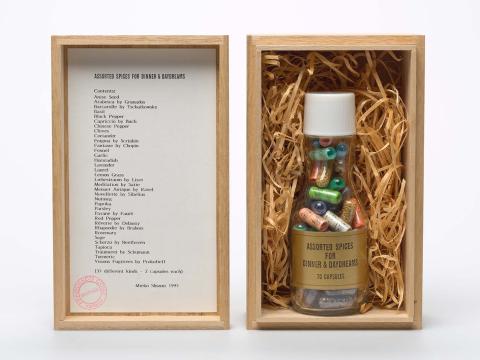‘Change Generators’
When celebrated French artist Marcel Duchamp (1887–1968) began presenting mass-produced, utilitarian objects – which he called ‘readymades’ – in a gallery setting, he disrupted the centuries-long concept of the artist as a skilled creator of original, handmade art. This Collection display features works by artists who alter everyday items to transform how we think about them and about art itself.
Australian glassblower Nick Mount has reworked the prosaic, industrial funnel and cylinder into vivid, sensuous sculptures, aiming to reinsert ideas of artisanal skill, usefulness and beauty into the intersecting forms. Lorraine Connelly-Northey weaves together disused industrial components and imbues them with the history and culture of her Waradjerie people in Victoria. Her Narbong (String bag) 2008, made from salvaged rabbit-proof fencing wire, is particularly potent given the impact of colonial history on Australia’s First Peoples. Similarly political are the sculptures of artist Romuald Hazoumè from the Republic of Benin, West Africa. Assembled from recycled materials, Nest Violeta and Wax Rasta 2009 are intended to disrupt the historical appropriation of African masks by European modernists and highlight the social and economic inequities between his continent and the West. Stuart Ringholt cheekily repurposes mundane articles, making real the illogical possibilities of popular drink cans doubling as aerosol containers, or double-ended pencils and cigarettes.
Like Duchamp, German artist Joseph Beuys (1921–86) established a legacy in art history for elevating common materials to art – things he associated with life-affirming properties, particularly fat, felt and honey. Beuys’s belief in olive oil as a fundamental, warming substance is the basis for his J. Beuys, olive oil bottle 1984. The poetry behind Mieko Shiomi’s delightful assemblage of Assorted spices for dinner & daydreams 1995 lifts its contents out of the kitchen and into the imagination, evoking memories and emotions as well as the senses. Ai Weiwei claims to have collected real and fake Neolithic ceramics that he then obscured with bright pigment for Painted vases 2006. The artist’s provocative gesture demonstrates another way that artists have altered the historical legacy and cultural and social meaning of things by giving them creative reign as art.
‘Change Generators’ was on display in GOMA’s Foyer Cabinet from 29 May to 31 October 2021.
Feature image (l–r): Nick Mount’s Cylinders and funnels 1980 and Ai Weiwei’s Painted vases 2006 installed for ‘Change Generators’, GOMA, May 2021 / © The artists / Photograph: N Harth, QAGOMA
Connected objects

Double pencil 2008
- RINGHOLT, Stuart - Creator

Double cigarette 2008
- RINGHOLT, Stuart - Creator

Aerosol Coca-Cola 2009
- RINGHOLT, Stuart - Creator

Aerosol Fosters 2009
- RINGHOLT, Stuart - Creator

Cylinders and funnels 1980
- MOUNT, Nick - Creator

Painted vases 2006
- AI Weiwei - Creator

J. Beuys, olive oil bottle 1984
- BEUYS, Joseph - Creator

Wax Rasta 2009
- HAZOUME, Romuald - Creator

Nest Violeta 2009
- HAZOUME, Romuald - Creator

